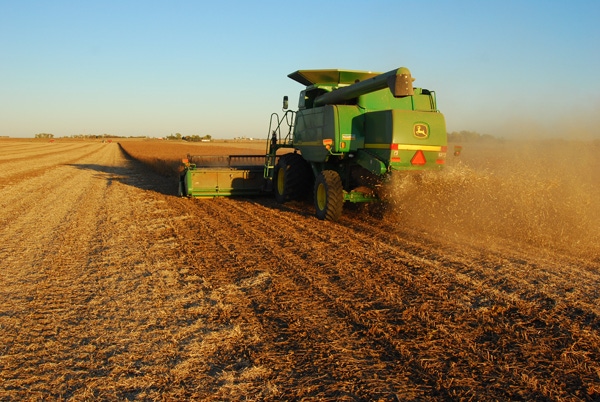September 24, 2012

Several fundamental factors have contributed to the decline in soybean prices, including early reports of better-than-expected yields of the current U.S. crop, according to University of Illinois Agricultural Economist Darrel Good. He reports that November 2012 soybean futures reached a high of $17.89 on Sept. 4, but have declined sharply since then. The USDA’s Sept. 12, Crop Production report containing a smaller yield and production forecast provided some brief support, but that contract has traded under $16 and is currently about $1.90 below the high. Basis levels have also weakened over the past three weeks.
“The average cash bid in central Illinois, for example, was 3¢ over November futures on Sept. 4 and 13¢ under on Sept. 21,” Good says.
The National Oilseed Processors Association reports the size of the domestic crush by its members in July was a bit smaller than expected. The July crush was 5% larger than that of the previous July, following year-over-year increases of nearly 14% in the previous three months. The total crush for the 2011-2012 marketing year may have been about 5 million bushels below the USDA forecast of 1.705 billion bushels.
Reports of an economic slowdown in China have also weighed on soybean prices.
“China is the largest consumer and importer of soybeans, accounting for 28% of world consumption and 64% of world trade in the 2011-2012 marketing year,” Good says. “An economic slowdown there raises concerns about the strength of commodity demand, including soybeans, during the year ahead. In addition, the expectation of a large South American soybean crop in 2013 provides a threat to the demand for U.S. soybeans in the last half of the 2012-2013 marketing year,” he says.
Following the drought-reduced crop of 2012, the USDA projects an 11% increase in acreage and a 29% increase in South American soybean production in 2013.
Good says one of the more negative fundamental factors has been the early reports of better-than-expected yields of the current U.S. crop.
“The USDA’s weekly Crop Progress report showed only 10% of the acreage harvested as of Sept. 16, but the market seems to be spooked by reports of yields exceeding producer expectations,” Good says. “The USDA will provide a new yield forecast in the Oct. 11, Crop Production report. The September report forecast the U.S. average yield at 35.3 bu., 0.8 bu. below the August forecast. It is not unusual for a lower yield forecast in September to be followed by a higher forecast in October. In the previous 30 years, for example, the September forecast was below the August forecast 16 times and the October forecast was above the September forecast in seven of those 16 years. The September-to-October increase ranged from 0.2 bu. to 3.5 bu. (2004) and averaged 1.3 bu.,” he says.
Good says that the October report will also provide an update of planted and harvested acreage of soybeans. The current estimate of planted acreage of 76.08 million is 1.6% larger than the USDA’s Farm Service Agency report of planted acreage by program participants. That ratio is consistent with that of the previous four years, suggesting little change in the National Agricultural Statistics Service estimate. The current forecast of harvested acreage is 1.445 million less than the estimate of planted acreage. The difference is 400,000 to 500,000 larger than the difference experienced in years of favorable weather and is consistent with the 2012 growing season weather.
While soybean fundamentals have turned somewhat negative, there have been some positive developments.
“First, early season weather in South America has not been perfect,” Good says. “While current weather does not threaten the upcoming crop, it is a reminder that the record crop there is not yet harvested. Second, export sales of U.S. soybeans for delivery during the 2012-13 marketing year were reported at 779 million bushels as of Sept. 13. That is a record level of sales for this time of the year and represents nearly 74% of the USDA’s projection of exports for the year. With 61% of the sales to China and 23% to unknown destinations, there is some concern about cancellation of some sales if prices continue to decline. In addition, the pace of exports during the first three weeks of the marketing year was very slow relative to the pace needed to reach the USDA projection for the year,” he says.
Good says that a third positive development is the decision by the EPA to increase the minimum biodiesel production from 1 billion gallons in 2012 to 1.28 billion gallons in 2013. “That increase will likely require an additional 2 billion pounds of vegetable oil for biodiesel production,” he says. “It represents about 7% of total U.S vegetable oil consumption in 2011-2012. More than the minimum amount of biodiesel may be needed to meet the total advanced biofuels requirement in 2013.
“A soybean price rally would not be expected at harvest time, particularly if the USDA confirms prospects for a larger crop. However, the on-going tightness of supplies and the need to further ration consumption should provide some underlying price support through the end of the calendar year,” Good says.
You May Also Like




